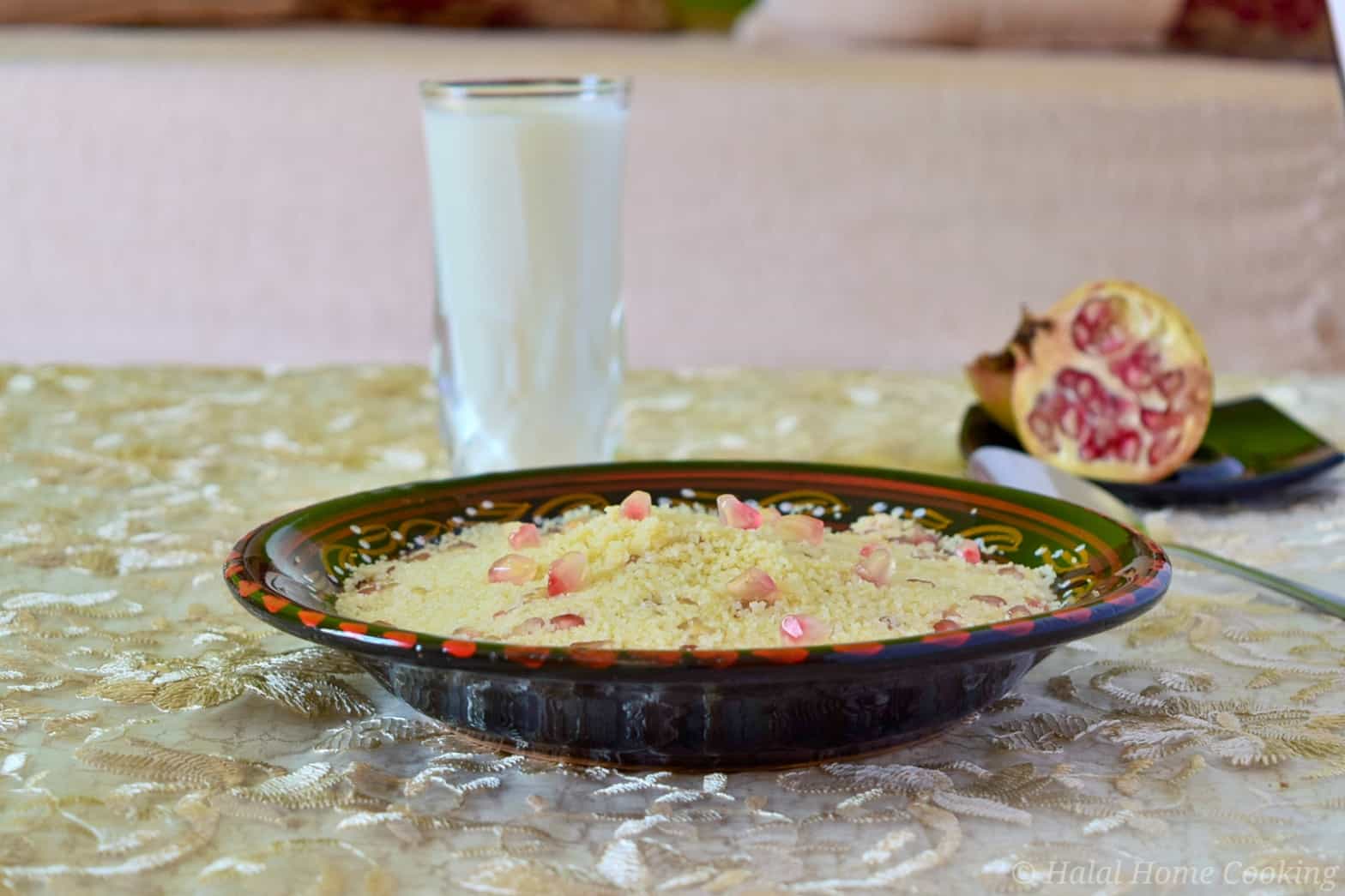Breakfast, dinner or dessert; Algerian Couscous with Pomegranate.
Traditionally-steamed, soft & fluffy couscous with bursts of sweet sour pomegranate arils.
The recipe is a simple one in terms of ingredients, only four (five if you are counting water?) and one of those is optional.
I grant you, 3 x steaming couscous is a little tedious and takes up 90% of time. Although that is mostly hands-off and the resulting soft fluffy couscous is, in my opinion worth the time and effort.
Pomegranates
The modern world of science has told us the numerous health benefits of eating pomegranates.
Before this Muslims already held the pomegranate, رمان by arabic, grenade by french, in high regard. It is a fruit mentioned in the Quran. Dates, Olives, Figs, Bananas and Grapes are also mentioned.
Pomegranate Arils
At first when I heard the word aril, I assumed it was just a posh word for seed. It’s actually the extra covering for the seed, the ‘fleshy’ juicy part as it were.
Removing arils is tricky. To encourage the arils out, I like slicing pomegranates in half and whacking the skin with the back of a wooden spoon. When I tire of seeing the arils go everywhere but the plate/bowl I’ve set up, I finish picking the rest by hand.
How to tell when a Pomegranate is ripe?
The pomegranate arils mostly pictured in this post, aren’t fully ripe. Still, I like the pink-white ombré look and they are sufficiently sweet.
In Algeria (and the rest of the Northern hemisphere) pomegranates are in season from September to February.
Apparently you can tell a pomegranate is ripe when the skin is red. However, that theory has been proven wrong in my case many times. Brilliant red pomegranates have been opened to find almost pure white arils. While green poms have given fully pink/red arils.
I have found a good indication of ripeness to be when the skin is cracked, as though the arils are bursting to get out.
The variety of couscous dishes
A lot of you will be familiar with Maghrebian-style couscous; traditionally steamed in a keskes (couscoussier) over a meat and vegetable broth-like sauce, that it is later served with.
There are in fact many ‘dry’, that is to say sauceless couscous dishes.
I’ve already shared Mesfouf with broad beans and peas and Mesfouf with dried fruits & nuts. These and this Algerian couscous with pomegranate are typically winter/spring dishes.
In summer you will find couscous is served with watermelon or grapes.
Serving Suggestions
I typically eat Algerian Couscous with Pomegranate at room temperature or only slightly warm.
If serving couscous hot, have a seperate bowl of pomegrante arils on the side. Scoop as many arils as you like per spoonful of couscous. Keeping the fruit separate prevents the arils bursting/turning brown.
Eaten slightly warm I find it so moreish, there isn’t time for the arils to burst, cook or turn brown. As I eat the dishful rather too quickly.
Lban – Maghrebi buttermilk, can and is often served in a glass besides, or mixed into, all the above ‘dry’ couscous dishes. It is rather an acquired taste which I usually opt out of, unless I’m in the mood for.
Don’t like the idea of eating sweet-savoury couscous alone for dinner? Try serving alongside grilled chicken skewers and salad.
As a dessert you can make it sweeter by sprinkling sugar (powdered or regular), drizzling honey or even pomegranate molasses for an extra sweet-sour tang.
As you have read above, masfouf bel rumman is a simple dish which can be served in a variety of ways. Onto the recipe….

